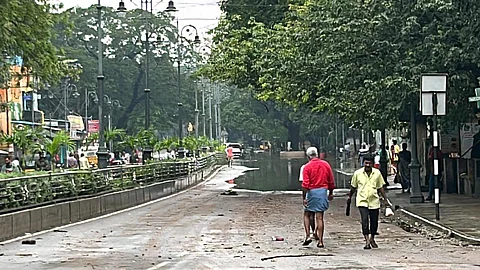

As floods wreak havoc upon Chennai city amid intense rainfall triggered by Cyclone Michaung originating in the Bay of Bengal, experts point to the reason — this time it’s the translational speed of the cyclone, unlike in 2015.
“Today’s scenario is in sharp contrast with what happened in 2015 because a cyclone hadn’t formed at the time,” S Abhilash, assistant professor at Advanced Centre for Atmospheric Radar Research, Cochin University of Science and Technology (CUSAT), told TNM. “In 2015, it had only just progressed to the deep depression stage, falling short of intensifying into a full-fledged cyclone,” he said. He added that the landfall then had also happened in Puducherry, directly in Tamil Nadu, which intensified the impact.
Abhilash said the Cyclone Michaung’s translational speed — speed at which it travelled from the sea to the land — was 8 to 10 kilometres per hour, which in turn reduced its travelling speed on land. “Usually when a cyclone is formed, it travels at a speed of 200 to 250 kilometres in 24 hours. But in this case, Cyclone Michaung has travelled only 100 to 120 kilometres per hour. This made it extend its sojourn in a specific region, causing rains in Chennai,” he said.
The cyclone had a curvature near Chennai which contributed to a significant reduction in its translational speed, resulting in a prolonged period of stagnant weather patterns, with rains confined to land rather than dissipating over the sea, Abhilash said. “Besides, despite its circular form, Cyclone Michaung exhibited asymmetry, leading to extreme rainfall in certain regions and extreme wind in others. So Chennai ended up experiencing the brunt of the rains, albeit in a less severe form than in 2015,” he said. He added that the impact of the cyclone also depends on Chennai’s infrastructure, the limitations of which will amplify the consequences of the weather event compared to other regions.
Abhilash warned that on December 5, Cyclone Michaung will badly hit the coast of Andhra Pradesh, where it will have a direct landfall. “As the cyclone prepares to make its presence felt along the Andhra Pradesh coast, it is expected that wind effects will predominate there,” he said.
He also pointed out that an accurate prediction of Cyclone Michaung was made, highlighted by a red alert issued two weeks prior, allowing for a calculated anticipation of the impending rains and winds. He said the cyclone’s impact on Tamil Nadu waned by December 4 and moved to the Andhra coast. “The cyclonic season is also drawing to a close. Cyclone Michaung is the sole cyclone that has been named this season. The likelihood of another cyclone soon seems unlikely as of now,” he said.